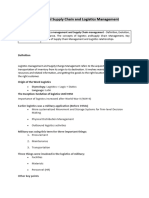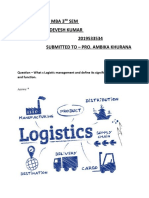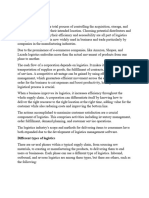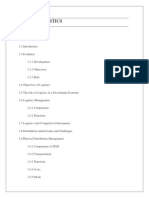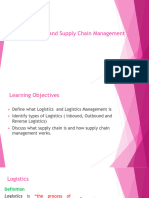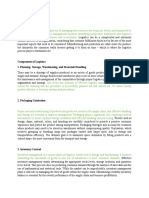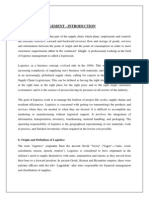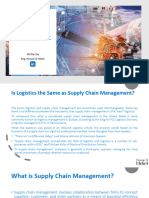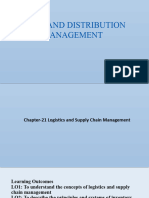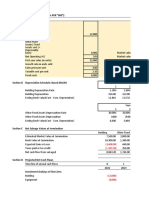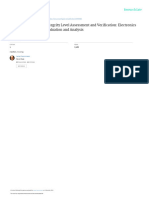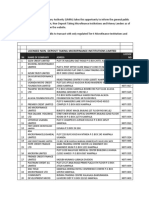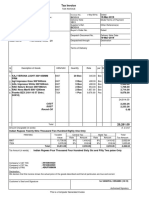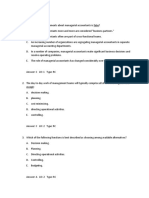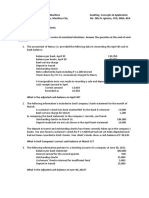LSM Module 1
Uploaded by
Parvathi Salera J - 4JN19CS065LSM Module 1
Uploaded by
Parvathi Salera J - 4JN19CS065Logistics and Supply Chain Management -1
Module-1
Introduction to Logistics Management
Introduction
Logistics is the management of supply and transportation to deliver the goods on time and
in good shape. handling of operations is a part of the logistics industry, and the need to
perform efficient and cheap operations is of utmost importance in the modern competitive
world. Managing a warehouse or warehousing means keeping track of inventory and making
sure orders are filled. It also involves managing warehouse infrastructure and processes,
such as in a fulfillment center, where orders are received, processed, and sent out (shipped
to the customer).
Most warehousing operations use software like ERP to manage the warehouse efficiently.
Warehousing as an industry is a part of the logistics industry. Customs management,
also called "global commerce management," is often thought of as a part of logistics
because of the paperwork that must be done at international borders and shipping ports to
show that government rules are being followed. Artificial intelligence (AI) and driverless
vehicle technology are expected to have a big impact on logistics in the future. Some
logistics companies are already using AI to improve package tracking and predict problems
based on their algorithms. With the use of modern algorithms, it is becoming possible to
predict future problems and solve the problems in advance. In the meantime, driverless
vehicles like forklifts, delivery trucks, and drones will become more common in warehouses,
warehouse yards, and highways.
Definition of Logistics
According to Robert A. Novack:
"Logistics is an activity involving the creation of time, place, form and possession of utilities
within and among firms and individuals through strategic management to create
products/services that satisfy the customer through the attainment of value”.
“The aspect of military science dealing with the procurement, maintenance, and
transportation of military matériel, facilities, and personnel.”
Definition of Logistics management
Logistics has been called by many names, including the following
• Business logistics
• Channel Management
• Distribution
• Industrial Logistics
• Logistics Management
• Materials Management
• Physical Distribution
• Quick-response Systems
• Supply Chain Management
• Supply Management
The above terms have in common that they deal with the management of the flow of goods
or materials from the point of origin to the point of consumption and in some cases the
logistics of supplying products to highly populated cities like Bombay, and Bengaluru is
difficult and complex. Highly efficient and effective logistics systems provide consumers with
goods and services that improve their standard of living.
Department of Management Studies, JNNCE, Shimoga 1
Logistics and Supply Chain Management -1
Logistics Management Defined
According to the CLM (Council of Logistics Management) “The process of planning,
implementing and controlling the efficient, effective flow and storage of goods, services,
and related information from the point of origin to the point of consumption to conform to
customer requirements”.
According to Philip Kotler, “Market logistics involves planning, implementing and controlling
the physical flow of material and final (finished) goods from the point of origin to the point
of use to meet customer requirements, at a profit”.
Five Important Elements/Activities of Logistics Management
Logistics management is complex and fundamental for companies in managing their supply
chain. The key components create and enforce consistency in the movement of goods from
manufacturer to distributor or consumer. It defines the logistics activities within the supply
chain. Having a deep knowledge and understanding of the key components of logistics
management is crucial as the industry changes and pushes for faster and more effective
logistics to get a product into the hands of the consumer or distributor. To help improve the
process, one must dive into the key components. Here are the five major components of
logistics management:
1. Planning: storage, warehousing, and materials handling
2. Packaging and utilization
3. Inventory control
4. Transportation
5. Information and Control
Understanding each element of logistics is a simple and effective way to recognize how
logistics activities and processes take part in the supply chain.
1. Planning: Storage, Warehousing, and Materials Handling
The market is unpredictable and highly susceptible to the imbalances between supply and
demand. Supply can be steady, but the demand for goods from consumers is not. It is
directly affected by different factors, making it unpredictable. Logistics management plays a
key role in ensuring a constant and continuous supply of goods from the manufacturer to
the consumer. Great planning becomes essential to maintain a healthy supply chain.
Department of Management Studies, JNNCE, Shimoga 2
Logistics and Supply Chain Management -1
During the fluctuation of supply and demand, there can be an insufficient supply of goods or
a surplus of goods produced. In such cases, storage units and warehouses become part of
the process. Proper logistics planning provides organization and synergy and becomes
essential to ensure proper maintenance and handling of the goods. Planning is one of the
most important components of Logistics management. It is essential to ensure all elements
of the process are coordinated and implemented successfully. It creates systems and
processes to achieve timely delivery of products.
2. Packaging Unitization
Care and conditioning of the products and goods are essential in the supply chain. Proper
handling and storing of products are key in logistics management. The packaging of the
products takes a lot of research. Analyzing the way the goods are stored to keep them at
their best quality, and strategizing how the package itself can be handled and processed is
part of the research and strategy. In addition, the colors and branding play a big part in
ensuring the consumer gets a positive experience.
The design, the shape, the material, and even the colors of the packaging are thought out to
successfully get the product to the right hands in the best condition possible. Packaging
protects a product as it is being transported from the manufacturer to the hands of the
consumer or distributor. But when supply and demand fluctuate, that package might need
to sit in a warehouse in the process. That goes into the packaging strategy as well. It must
maintain and condition the product in such scenarios, without jeopardizing the
quality. Unitization assists in the storage and transportation of goods and products.
Essentially, it is a “grouped or bundled cargo, wrapped into packages and loaded onto or
inside a bigger unit”.
The end goal is to fit products and goods in a cube, the easiest shape to transport and store.
Packaging and unitization work together on packing all different shapes and sizes of
products and goods into a cuboid shape.
3. Inventory Control
Inventory is closely related to storage and warehousing and is important to ensure
consumer requirements are met. It is about controlling the flow of goods and products
going in and out of the warehouses. It determines how much stock to hold, where to store,
and how much is to be stored. Inventory management is about predicting the demand for
goods by consumers with the help of sales data, and mathematical and statistical tools. As
previously mentioned, the market varies and can sometimes be unpredictable.
Inventory management is not an exact science, but it is an important logistics element to
help manage the flow of goods through the supply chain. A healthy inventory balance is
detrimental to the supply chain and business margins.
4. Transportation
Transportation is a complex and costly part of logistics management. It can represent 50
percent of the logistics budget, putting pressure on companies to find the fastest and most
cost-effective way to get products and goods to the consumers and distributors.
Transportation includes various platforms, such as road vehicles, cargo trains, freight
shipping, and air transport. Perishables do not travel far, but many other goods travel from
all over the world, adding complexity to the process such as tax codes, customs clearance,
and payment methods. All of these must be cleared before the products even leave the
warehouse.
Department of Management Studies, JNNCE, Shimoga 3
Logistics and Supply Chain Management -1
Transportation plays a key role in the fast-growing industry of e-commerce. The consumer
has high expectations for fast and proper delivery of goods, and even the return of such.
When partnering with a 3PL, it is important to work with a company that provides reliable
and transparent logistic services to ensure quality and efficiency.
5. Information and Control
Data-driven logistics drive the future of the industry. The flow of information throughout
the logistics management process is vital to providing fast and accurate service to
consumers and manufacturers. From inventory flow to warehouses and transportation,
information improves the efficiency and performance of activities in a supply chain.
Information and control improve business efficiency helping in the traditional management
processes, but also supporting as a modern tool in achieving strategic goals.
Analyzing and understanding the five components of logistics management thoroughly is a
constructive business practice as advances continue to shape the components of logistics
management, change the industry, and improve the technologies.
Department of Management Studies, JNNCE, Shimoga 4
Logistics and Supply Chain Management -1
Types of Logistics
1. Inbound Logistics
Inbound logistics is used to execute strategic organizational tasks for working upstream.
Under this inbound logistics, the movement, transportation, and storage solutions of various
information and products from the suppliers are passed onto the warehouse and then
transferred to the production facilities for further processing and production. Inbound
logistics is all about the transportation between the companies and their suppliers. The
logistic firms intend to use order-fulfillment systems or automatic ordering for proficiently
managing the inbound logistics. With this integration, a company can expect to enhance the
successful aspects of the organization. For instance, if the company is manufacturing car
parts in a factory, it will need to ship them to businesses or recipients such as
manufacturers, to implement them upon the finished products.
The job of inbound logistics is to transfer the crude or raw materials to the respective
departments or manufacturers for further processing. Large trucks are mostly preferred for
transporting these crude raw materials. Logistics companies have wide networks and large
trucks to safely transport the goods without much cost. It is the first step within the value
chain of logistics, for which it is important to seek better process flow, to avoid hampering
the remaining processes.
2. Outbound Logistics
Outbound logistics is the movement of products or finished goods from the production
centers to the next supply chain link. After that, these products are moved from the
warehouse to the consumption point or the customers. Hence, outbound logistics is also
known as the process of order fulfillment. All the products that are shipped under outbound
logistics are meant for end-users, moving through this process flow. The inbound logistics is
used to help the raw materials reach out to the manufacturer, and the processed product is
then transported to the end-users through outbound logistics. In simple terms outbound
services allow businesses to ship and deliver their specified products from warehouse
storage to the customer’s doorstep. There are separate sets of tracking solutions available
for the end-users to monitor the movement of their parcel. Extra care should be taken as
outbound logistics play a major role in building the reputation of businesses, as customers
expect on-time and safe delivery of their goods or products.
3. Reverse Logistics
As the name suggests, Reverse Logistics is the transportation of goods or products from the
end-users to the supply chain. Reverse logistics is needed in the event of a replacement or
return of products for refurbishing, repairing, exchange, disposal, or recycling. Reverse
logistics is basically carried out after the sale is done and is mostly opted for by the
electronics and automobile industry but is also used for products associated with all other
sectors. Suppose, a company delivers a product that doesn’t fit the purpose or is wrongly
manufactured. One will have to send it back to the supplier for repair or replacement of the
same. In such scenarios, reverse logistics is required to get it done smoothly.
4. Third Party Logistics (3PL Logistics)
Third-party logistics (or 3PL) is known as outsourcing operational or e-commerce logistics to
a third-party logistics company that handles everything from inventory management to
delivery of the products. This enables business owners to focus on their core business while
the order fulfillment operations are handled smoothly by a 3PL provider. A 3PL specialist
company provides a wide range of services that support the logistics of the supply chain.
Department of Management Studies, JNNCE, Shimoga 5
Logistics and Supply Chain Management -1
The services include transportation, warehousing, inventory management, picking and
packing, freight forwarding, and reverse logistics/returns.
5. Fourth Party Logistics (4PL)
4PL or fourth-party logistics is used by companies to outsource all of their logistics
operations to a single logistics partner. The logistics provider would be responsible for
managing the entire supply chain including assessing, designing, building, running, and
tracking supply chain solutions for the client. This is why a 4PL logistics partner represents a
higher level of supply chain management for the client. Having a 4PL logistics partner has
many benefits.
Objectives of Logistics
1) Improving Customer Service: By attaining customer satisfaction, the highest level of
profits can be ensured. Thus, continuous improvement in customer service acts as the core
objective of logistics.
2) Speedy Response: It refers to the organization's ability to give prompt responses to the
customer's queries. In today's era of IT, it has become completely manageable to give
immediate responses to customers' queries by acquiring related data and postponing
logistical functions to the latest time to increase the response rate.
3) Decreasing Costs of Total Distribution: Decreasing the costs associated with overall
distribution is another vital objective of logistics. The expenses on the distribution of goods
include expenditures on shipment, storage, record keeping, etc. As these processes are
interlinked, reducing the cost of one function often increases the cost of the other.
4) Consistent and Reliable Delivery Performance: Ensuring consistent and reliable delivery
performance is another main objective of logistics. This will significantly help companies to
strengthen their relationships with customers by developing trust and gaining confidence.
5) Least Product Damages: Damaged products contribute to extra expenditure on logistics.
This extravagant expenditure on damage can be avoided by using a mechanical system for
handling materials and using a logical and efficient system of packaging.
6) Creating Additional Sales: One of the other aims of logistics is to increase sales by
creating additional sales. This can be attained by providing better services most
economically.
7) Generating Place and Time Utilities: Ensuring the utility of the product at the right time
and right place is another main objective of logistical functions. The product is not good for
the consumers until it reaches them at the right place and right time.
8) Stability of Costs: Another purpose of logistics is to ensure the stability of costs. It can be
attained by managing the supply of goods through thoughtful use of accessible
transportation and suitable storage facilities.
9) Upgrading Quality: In the long run, logistics seeks to ensure continuous quality
improvement. Total Quality Management has emerged as a primary obligation in all parts of
the industry within this aspect. Its assurance is mainly responsible for logistical
regeneration.
10) Life cycle Support: A sound logistical system is mainly responsible for maintaining
healthy PLC. Sometimes goods are sold without giving a guarantee regarding their lasting
performance as advertised. These situations call for reversing the direction of normal value-
added inventory offered to the customers.
Department of Management Studies, JNNCE, Shimoga 6
Logistics and Supply Chain Management -1
11) Movement Consolidation: Transportation cost is one of the most important logistical
costs as logistics aims to reduce costs through consolidation and integration of operations. It
is directly related to the product type, shipment Size, distance, etc. Thus, movement
consolidation becomes desirable for ensuring the reduction in transportation costs.
12) Inventory Reduction: One of the major factors which can prove to be unfavorable for
the firm is heaps of records. Conventionally, abundant inventory was maintained to ensure
good customer care services, which indulged a lot of expenditure. Thus, inventory reduction
is another main objective of logistics. The below diagram presents the Objectives of the
Logistics.
Importance of Logistics
The importance/ Advantages of logistics can be stated as follows :
1) Form Utility: It refers to the procedure through which goods and services are produced
and put into appropriate form for usage by the customers. Form utility refers to the worth
of a product that has been created by putting together all its parts.
For example, a mobile screen has some form of utility, but a complete cell phone has a high
level of form utility. It is the indirect application of logistics that helps in using time and
place utilities, through which various parts of final products are combined.
2) Possession Utility: It refers to the value added to the goods or services so that the
customer is able to possess it. It is usually arranged by providing loans, credits, etc. By
Department of Management Studies, JNNCE, Shimoga 7
Logistics and Supply Chain Management -1
offering products and services to consumers at fixed time and place, logistics becomes
indirectly responsible for providing possession utility through place and time utility.
3) Time Utility: It refers to the value of getting the product when required. Time utility
occurs within the firm so that all the materials and parts are available at the right time and
the production line remains unaffected. Logistics here influence time utility as it helps in
creating value for customers by timely delivering the product to customers or making it
available in the market for purchase when required.
4) Place Utility: It implies that all the requisite goods/services are available at the right place
when required. If a product required by a customer is on its way, in a warehouse, or some
other store, it fails to serve the purpose of place utility for the customer. The place utility is
considered to be the value acquired by providing the requisite goods/services available at
the right place.
Evolution of Logistics Toward Supply Chain Management
Logistics was first applied and recognized in military operations, and its most significant
impact is felt through the functions of production, distribution, and consumption (Rodrigue
and Slack, 2002). It became a large-scale activity during the industrial revolution. The origins
of the modern distribution sector date back to the emergence of the capitalist economy, the
development of specific modes of industrial production and the deployment of a particular
division of labor. This creates a distinct “sphere of circulation” between production and
consumption (Marx, 1939/1953). To a certain extent, circulation enabled the transition from
use value to exchange value and thus made possible the large-scale capitalization of
commodities. Retailing and marketing have become part of modern management practice
(Chandler, 1977) and have been important factors in the wealth generation.
The Chronological Evolution of Logistics & Supply Chain Concepts
The first form of the chronological evolution of the concepts of logistics and the supply chain
implies the existence of 7 distinct and important phases as shown in Figure 1.
• The First: The Transportation Era (1950s)
• The Second: The Physical Distribution (1960s)
• The Third: Physical Supply, Deregulation and Logistics (1970s)
• The Fourth: Transportation, Deregulation, Physical Distribution and Business
Logistics (1980s)
• The Fifth: Business Logistics (1990s)
Department of Management Studies, JNNCE, Shimoga 8
Logistics and Supply Chain Management -1
• The Sixth: Logistics and Supply Chain Management (2000s)
• The Seventh: Supply Chain Digitalization (2010’s)
The 1950s – The Transportation Era
In the 1950s, transportation was in focus. Several universities offered courses in the field of
transportation. However, topics such as logistics, physical sourcing and supply chain
management are not included in these courses. There were no computers or even pocket
calculators back then that could help quantify data (R. Neil Southern, 2011). There is also
not much discussion (if any) about the systems approach or the concept of total cost. The
idea of working with suppliers or customers was not a priority for most managers at the
time. The term logistics is mainly used in the military field. In times of war, having the right
supplies in the right place at the right time is critical. The main player in the 1950s was the
federal government.
For example, the most significant event related to logistics (or transportation) was the
Federal Aid Highway Act of 1956, which authorized the National Interstate Highway and
Defense Highway System. The Interstate Commerce Commission (ICC) (founded in 1887) is
the economic regulator of road and rail transportation. All road and rail freight duties and
regulations regarding the entry of road carriers are under the jurisdiction of the
International Chamber of Commerce. The ICC also regulates the closure of railway lines. In
the 1950s, several agencies were available for transporting students and practitioners. Many
companies encourage their transportation professionals to pass the ICC Practitioner exam
administered by the ICC Practitioners Association (now the Transportation Practitioners
Association 1984, the Transportation Law, Logistics and Policy Association 1994).
The 1960s – Physical Distribution
The study of transportation in the 1960s evolved into the study of logistics, and to a lesser
extent, logistics. The National Council of Physical Distribution Management (NCPDM) was
established in 1963 to represent professional logistics managers. This organization was
renamed the Council of Logistics Management (CLM) in 1985 and the Council of Supply
Chain Management Professionals (CSCMP) in 2004. Today, CSCMP has more than 14,000
members. In most cases, logistics (outbound logistics) and physical supply (inbound logistics)
are seen as two distinct functions. This was reflected in the two major organizations of the
time. Founded in 1963, NCPDM represents the outbound side of logistics and the National
Association for Purchasing Management (NAPM) represents the inbound side. During this
decade, one of the first textbooks to focus on logistics distribution and logistics was Logistics
Management: Logistics Problems in the Enterprise (Smykay, Bowersox, and Mossman 1961)
(R. Neil Southern, 2011).
While logistics received a lot of attention in the literature in the 1960s, with transportation
as the most important function of logistics. In the fall of 1961, the American Transportation
Association published its first issue of Transportation Magazine. In 1966, President Lyndon
B. Johnson signed Public Law 89–670 establishing the Department of Transportation, and
Alan S. Boyd was elected the nation’s first Secretary of Transportation.
The 1970s – Physical Supply, Deregulation and Logistics
In the early 1970s, the physical supply (sometimes referred to as material management) of
the input side of the logistics system was taken over. Later in the century, there was a
movement to combine physical distribution with physical delivery, with an emphasis on
broader logistics concepts. The 1970s were a pivotal decade for the further development of
Department of Management Studies, JNNCE, Shimoga 9
Logistics and Supply Chain Management -1
the logistics concept. Universities, scholarly journals and textbooks, and professional
organizations all contributed to making the decade productive (R. Neil Southern, 2011).
Transportation is also further emphasized as the most important function in logistics
management. During the period of the 1970s, the Transportation Journal emerged as one of
the leading academic journals in the discipline of transportation and logistics. This is
because the latter has published a set of articles in the fields of economics, industrial
management, carriers, physical distribution, logistics, regulation, public policy, education,
and communication. other relevant topics in particular. JBL’s production took place at The
Ohio State University. Professor Bernard “Bud” LaLonde was JBL’s first editor (Miyazaki,
Anthony D. and al. (1999)).
The 1980s – Transportation Deregulation, Physical Distribution and Business
Logistics
During the 1980s, and specifically in the world of transport, deregulation continued with
the Motor Carrier Act of 1980, which reduced regulation of road freight rates and entry
conditions. The Staggers Rail Act of 1980 allowed the railways to negotiate contracts and
operate with less oversight by the ICC. Federal deregulation of transportation in the United
States has resulted in a more competitive and flexible system (R. Neil Southern, 2011).
The term physical distribution began to be phased out during the 1980s, and the term
logistics came to the fore. For example, James C. Johnson and Donald F. Wood changed the
name of their textbook Contemporary Physical Distribution to Contemporary Physical
Distribution and Logistics. The NCPDM changed its name to the Council of Logistics
Management (CLM) in 1985.
The 1990s – Business Logistics
During the period of the 1990s, business logistics continued to be a very essential element.
Most cost-focused companies have realized that there are opportunities for cost savings
through negotiations with carriers and the implementation of the systems approach and
total cost concept. Johnson and Wood, in their fourth edition of their textbook, dropped
Physical Distribution from the title, to simply become Contemporary Logistics. Many
transport companies have exploited the concept of logistics, using it from a theoretical
angle, promoting the idea that they were not only transport companies, that they were
logistics carriers, or that they provided logistical solutions (R. Neil Southern, 2011).
During the 1990s, the main factors affecting logistics were the rapid development in
electronics and communication technologies, such as the Internet and electronic data
interchange. The growth of third-party logistics organizations, strategic alliances, and
partnerships has also been significant. Companies have started to see logistics as an integral
part of overall business strategy.
The 2000s – Logistics and Supply Chain Management
The early years of the 21st century have seen a slow evolution from logistics to supply chain
management in academia and business. As part of the business world, small and medium
enterprises have been slower to accept the supply chain concept.
Supply chain management has therefore come to be seen as a chain that encompasses the
planning and management of all activities involved in sourcing and converting and all
logistics management activities. The Transport and Logistics Basics textbook states: “The
supply chain includes all partners in the logistics process. The idea is to have integrated
information sharing between all trading partners (suppliers, manufacturers, and
customers)”.
Department of Management Studies, JNNCE, Shimoga 10
Logistics and Supply Chain Management -1
This assessment of logistics and supply chain management over the past few years would
not be complete without a mention of development through online and distance education
in logistics and supply chain management. It would be rare to find a college or university
that didn’t have some sort of online presence. Distance learning is an important part of
teaching logistics.
The 2010 – present – The Era of Supply Chain Digitalization
The digitalization of the Supply Chain corresponds to the dematerialization of information
processing. This digitalization offers better management of data flows as well as
unparalleled reliability of information related to the Supply Chain. For optimal production
flow management, the digitalization of flows (physical logistics flow or logistics just-in-time)
is therefore essential.
Nowadays, different types of businesses find themselves faced with increased and
globalized competition. To remain competitive, the digitization of the supply chain has
become necessary. The benefits of the digital supply chains are no longer debated.
Logistics Industry in India
India continues to be the fastest-growing major economy. Indian economy remains least
susceptible to the global recession. India being one of the fastest-growing economies in the
world has a great potential for growth in every sector. The logistics sector is the backbone of
development and a strong and growing logistics sector indicates a healthy trend of a
growing economy. The logistics sector in India has always been about resilience, adapting to
new technologies, and agility. With better infrastructure, the Indian industry was able to
plan its businesses more efficiently, moving India closer to becoming a manufacturing hub
for the world.
According to a recent report by McKinsey Global Institute (MGI), India's logistics sector
would expand at a Compound Annual Growth Rate (CAGR) of more than 10 percent, from
$200 billion in early 2020 to at least $320 billion in 2025. This subsequently changed in 2020
due to the pandemic and businesses came up with innovative solutions to plan for the
future. In recent years, the Indian government has had a renewed focus on investing in
logistics infrastructure in the country, while at the same time encouraging investments from
the private sector as well. This has led to much better rail connectivity & road networks and
an increase in the number of ports, inland container depots, and warehousing services
throughout the country. The government has recently introduced PM Gathi Shakthi National
Master Plan for Multi-Modal Connectivity, which is a transformative approach for economic
growth and sustainable development in the logistics sector to achieve India's aim of a USD 5
Trillion economy. Along with the Bharatmala Pariyojana project, the government plans to
develop 35 Multi-Modal Logistics Parks to strengthen logistics and build transportation hubs
in the country for seamless connectivity via road, rail, and water. In the coming years, these
Parks will create over two lakh job opportunities and reduce logistics costs from 13-14% of
India's GDP to approx. 8-10% observed by developed countries.
Logistics – Indian Perspective
Logistics is of critical importance for both businesses and the economy. A robust and
efficient logistics sector of a country indicates an efficient forward and reverse of goods and
services, which ultimately translates to a fast-paced growth in the economy. According to a
recent EY report, “India@100: realizing the potential of a US$ 26t economy”, India is
projected to grow to US$26t by FY48. India’s transportation and logistics sector can act as
the backbone to support this fast-paced growth, which the country is poised to achieve in
Department of Management Studies, JNNCE, Shimoga 11
Logistics and Supply Chain Management -1
the next 25 years. India’s freight movement is heavily skewed toward road transportation,
which moves 66% of cargo (in ton-km). This is followed by rail (31%), shipping (3%) and air
(1%).
The sector continues to witness unevenness in freight transportation by mode and is
working toward solving this impediment. The ports, shipping and logistics industry in India is
shifting to align with the evolving business landscape. Improved infrastructure, increased
emphasis on digitalization, and a heightened focus on sustainable logistics are driving this
shift as the country sets its eyes on unleashing the potential of becoming a US$26 trillion
economy by FY48 (with US$6 trillion by FY30).
Logistics Costs
A logistical cost refers to any expense incurred by a business to manage its logistics.
Knowing how to reduce them is key to being more competitive. Logistics costs include
expenses related to resource acquisition, product distribution, and other expenses that
make up a company's chain of production, sales, and delivery. Logistics costs are driven or
created by the activities that support the logistics process. Each of the major cost categories
– customer service, transportation, warehousing, order processing and information, lot
quantity, and inventory carrying are detailed below.
Customer service level.
The key cost trade-off associated with varying levels of customer service is the cost of lost
sales. Monies that are spent to support customer service include the costs associated with
order fulfillment, parts, and service support. They also include the costs of return goods
handling, which has a major impact on a customer's perception of the organization’s service
as well as the ultimate level of customer satisfaction.
Cost of a lost sale
The cost of lost sales includes not only the lost contribution of the current sale, but also
potential future sales from the customer and from other customers due to word-of-mouth
negative publicity from former customers. A recent estimate indicated the every dissatisfied
customer tells and average of 9 others about his or her dissatisfaction with the product or
service. It is no wonder that it is extremely difficult to measure the true cost of customer
service.
The objective is to minimize Total costs given the customer service objectives.
Thus, the best approach is to determine desired levels of customer service based on
customer needs, and how those needs are affected by expenditures onother areas of the
marketing mix. The idea is to minimize the total cost, given the customer service objectives.
Because each of the other five major logistics cost elements work together to support
customer service, good data are needed regarding expenditures in each category.
Transportation Costs
The activity of transporting goods drives transportation costs. Expenditures that support
transportation can be used in many different ways, depending on the unit of analysis. Costs
can be categorized by customer, product line, type of channel such as inbound versus
outbound, and so on. Costs very considerably with the volume of shipment (cube) weight of
shipment, distance, and point of origin and destination. Costs and service also very
considerably with the mode of transportation chosen.
Department of Management Studies, JNNCE, Shimoga 12
Logistics and Supply Chain Management -1
Warehousing Costs
Warehousing costs are created by warehousing and storage activities, and by the plant and
warehouse site selection process. Included are all of the costs that vary due to a change in
the number or location of warehouses.
Order Processing/Information Systems costs
This category includes costs related to activities such as order processing, distribution,
communications, and forecasting demand. Order processing and information costs are
extremely important investments to support good customer service levels and control costs.
Examples of Order processing costs Include such costs as order transmittal, order entry,
processing the order, and related internal and external costs such as notifying carriers and
customers of shipping information and productive availability. Shippers and carriers have
invested a great deal in improving their information systems to include technology such as
electronic data interchange (EDI), satellite data transmission, and barcoding and scanning
shipments and sales. There also has been a growth in more sophisticated information
technology, such as decision support systems, artificial intelligence (AI), and expert systems.
Lot Quantity Costs
The major logistics lot quantity costs are due to procurement and production quantities. Lot
quantity costs are purchasing or production-related costs that vary with changes in order
size or frequency and include:
The Components of Lot Quantity Costs
1. Setup costs
a. Time required to set up a line or locate a supplier and place an order.
b. Scrap due to setting up the production line.
c. Operating inefficiency as the line begins to run, or as a new supplier is
brought on board.
2. Capacity lost due to downtime during the changeover of line or changeover to a new
supplier.
3. Materials handling, scheduling, and expediting.
4. Price differentials due to buying in different quantities.
5. Order costs associated with order placement and handling.
These costs must not be viewed in isolation because they also may affect many other cost.
For example, a consumer goods manufacturer that produces large production runs may get
good prices from suppliers and have long efficient production runs, but requires more
storage space to handle large runs. Customer service levels may suffer as order fulfillment
declines because products are produced infrequently, in large batches, and with inventory
going to zero and creating stock-out situations in between runs. This may increase
information and order processing costs, as customers frequently call to check on the
availability of back-ordered products and cancel back orders. Transportation costs also may
rise as customers are sent partial or split shipments. Inventory carrying costs will rise as
large quantities of inventory are held until depleted, due to large bath sizes. The implication
of one cost upon another must be explicitly considered.
Inventory carrying costs
The logistics activities that make up inventory carrying costs include inventory control,
packaging, and salvage and scrap disposal. Inventory-carrying causes are made up of many
elements. For decision-making purposes, the only relevant inventory costs to consider are:
Department of Management Studies, JNNCE, Shimoga 13
Logistics and Supply Chain Management -1
The Relevant Inventory Costs are those that vary with the amount of inventory and those
that vary with the amount of inventory stored.
1. Capital Costs, or Opportunity costs, are the returns that the company could make on
the money that it has tied up in inventory.
2. Inventory service cost, which includes insurance and taxes on inventory.
3. Storage space cost, which includes those warehousing space-related costs that
change with the level of inventory.
4. Inventory risk cost, including obsolescence, pilferage, relocation within the
inventory system, and damage.
Logistical Informational Requirements.
A Logistics Information System (LIS) is the implementation of solutions for a system of
records and reports which may be paper-based or electronic. This is a specialized area in
logistics that can handle location, work management, and data management in
organizations. It mainly includes coordination of demand, supply, movement, and control of
material or finished goods.
Role of Logistics Information System
Logistics Information System (LIS) is a system of records and reports whether paper-based
or electronic, used to aggregate, analyze, validate, and display data from all levels of the
logistics system that can be used to make logistics decisions and manage the supply chain.
The role of LIS can be understood from the following:
• LIS ensures the transformation of logistics functional operations into a process to
pursue customer satisfaction at the lowest cost. It facilitates the planning and
control of logistics activities related to order fulfillment.
• LIS provides information on goods and tracks the delivery, by giving their status.
• Logistics systems depend on outside information and international standards to
comply with regulations and use laid-down ways of sharing logistic information with
others.
• The manufacturers and traders monitor the actual products to know whether they
will arrive on time and in proper condition at the delivery places and to be able to
take prompt action in case of any lapse.
• Transporters focus on the progress and status of the means of transport. In case of
any delays or exigencies, transporters can report these to their customers who can
consider the impact.
• Customs authorities and those responsible for ensuring the safety and security of
goods during transportation are given details about the content of goods and their
means of transport.
Logistics Information System: Requirements And Components
Three types of information systems serve different organizational levels. These are
operational-level systems, management-level systems, and strategic-level systems.
Converting logistics data to information, representing it in a manner useful for decision-
making, and interfacing the information with decision-assisting methods are at the core of
LIS. There are certain requirements which are:
1. Organization decisions: These relate to the decisions to be made at each level of the
organization. While designing an information system, it must be ensured that the
concerned person is entitled to get the required information needed for decision-
making.
Department of Management Studies, JNNCE, Shimoga 14
Logistics and Supply Chain Management -1
2. System requirement: After deciding on collecting information, the next requirement
is the identification of the source of information, and the volume and quality of
information. A suitable channel of communication will have to be designed to satisfy
various requirements.
3. Control requirements. Based on guidelines given by the management of, the
Logistics Information System, the system should be able to aid in decision-making,
minimizing delays, and increasing efficiency. Control is required to ensure that no
errors are made.
4. System input and output data. To satisfy the demand of a customer, several
activities are undertaken by the organization, which need proper coordination.
Action reports are made to undertake activities based on generated information.
Key Components of LIS
LIS is designed to manage the flow of materials and information within and between
organizations and their business environment. Globally information technology is a critical
enabler of the logistics supply chain networks that businesses use to acquire, produce, and
deliver goods and services. The key components include:
1. Logistics Information Portal
2. Logistics Computing and Simulation
3. Decision Support System
4. Database
5. E-Logistics and E-Commerce
6. Software applications relating to Customer Relations Management (CRM), Enterprise
Resource Planning (ERP), Radio Frequency Identification (RFID) Tags, Transport
Management System (TMS), and Warehouse Management System (WMS).
Questions
3 Marks
1) What is Logistics?
2) What is Logistics management?
3) What is Inbound Logistics?
4) What is Outbound Logistics?
5) What is Reverse Logistics?
6) What is Third Party Logistics?
7) What is Fourth Party Logistics?
8) What is Lot Quantity Costs?
9) What is Inventory carrying costs?
7 Marks
1) Explain Importance of Logistics in Business
2) Explain Logistics Industry in India
3) Explain the Components of Lot Quantity Costs
4) Explain the Components of Inventory carrying costs
5) Explain Role of Logistics Information System
6) What are the Requirements of Logistics Information System?
7) What are the components of Logistics Information System?
Department of Management Studies, JNNCE, Shimoga 15
Logistics and Supply Chain Management -1
10 Marks
1) What are the major Activities of Logistics Management
2) Explain different Types of Logistics
3) What are the Objectives of Logistics?
4) Explain Evolution of Logistics Toward Supply Chain Management
5) Explain Different costs involved in Logistics
Department of Management Studies, JNNCE, Shimoga 16
You might also like
- Managing Supply Chains A Logistics Approach International Edition 9th Edition Coyle Langley Gibson Novack 111153392X Solution Manual100% (68)Managing Supply Chains A Logistics Approach International Edition 9th Edition Coyle Langley Gibson Novack 111153392X Solution Manual13 pages
- Solution Manual For Managing Supply Chains A Logistics Approach International Edition 9th Edition Coyle Langley Gibson Novack 111153392X 9781111533922100% (65)Solution Manual For Managing Supply Chains A Logistics Approach International Edition 9th Edition Coyle Langley Gibson Novack 111153392X 978111153392236 pages
- Assignment:-Mba 3 SEM Devesh Kumar 2019533534 Submitted To - Pro. Ambika KhuranaNo ratings yetAssignment:-Mba 3 SEM Devesh Kumar 2019533534 Submitted To - Pro. Ambika Khurana12 pages
- International Supply Chain and Logistics ManagementNo ratings yetInternational Supply Chain and Logistics Management98 pages
- Introduction To Retail Management Module 1100% (1)Introduction To Retail Management Module 152 pages
- Major Functions of Logistics ManagementNo ratings yetMajor Functions of Logistics Management38 pages
- Unit 6 - Logistics & Supply Chain Management - To StsNo ratings yetUnit 6 - Logistics & Supply Chain Management - To Sts50 pages
- Chapter 2 - Overview of Logistics Management - Introduction To Logistics and SCMNo ratings yetChapter 2 - Overview of Logistics Management - Introduction To Logistics and SCM40 pages
- Lecture 1 - Role of Logistics in Supply Chains (01 11 2024)No ratings yetLecture 1 - Role of Logistics in Supply Chains (01 11 2024)73 pages
- Sustainable Supply Chain Logistics MBA AssignmentNo ratings yetSustainable Supply Chain Logistics MBA Assignment23 pages
- Introduction To Logistics Management PDFNo ratings yetIntroduction To Logistics Management PDF65 pages
- Supply Chain and Logistics Management: Written by Eng. Hassan Al HelielNo ratings yetSupply Chain and Logistics Management: Written by Eng. Hassan Al Heliel46 pages
- Additional Notes On Logistic and Supply Chain ManagementNo ratings yetAdditional Notes On Logistic and Supply Chain Management8 pages
- Chapter 2 - Overview of Logistics Management - Introduction To Logistics and SCMNo ratings yetChapter 2 - Overview of Logistics Management - Introduction To Logistics and SCM40 pages
- Logistics23 B6 - Day3 - Logistics ManagementNo ratings yetLogistics23 B6 - Day3 - Logistics Management16 pages
- 22MBABA304 Exploratory Data Analysis For Business Study MaterialNo ratings yet22MBABA304 Exploratory Data Analysis For Business Study Material51 pages
- Luther Sanction Update June 2023 1687428419No ratings yetLuther Sanction Update June 2023 168742841919 pages
- A Case Study of Safety Integrity Level AssessmentNo ratings yetA Case Study of Safety Integrity Level Assessment13 pages
- SM5b-The Evolution of The Concept of Management Control Towards A Definition of Performance Management SystemNo ratings yetSM5b-The Evolution of The Concept of Management Control Towards A Definition of Performance Management System47 pages
- Shareholders' Equity Exercises & Solutions100% (1)Shareholders' Equity Exercises & Solutions26 pages
- Case Study S5: Dizplaze, Eric Woocock: Group MembersNo ratings yetCase Study S5: Dizplaze, Eric Woocock: Group Members4 pages
- Unit III - Market Survey & Opportunity IdentificationNo ratings yetUnit III - Market Survey & Opportunity Identification21 pages











